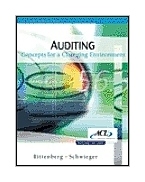|
||
• wydawnictwa polskie
• Zamów informacje o nowościach z wybranego tematu • kontakt
• Cookies na stronie |
AUDITINGRITTENBERG L., SCHWINGER B.wydawnictwo: THOMSON , rok wydania 2005, wydanie Vcena netto: The Fifth Edition presents current issues and adapts auditing approaches to business and economic complexities, focusing on the analysis of business risk and identifying fraud in the new auditing environment. Due to recent accounting, governance, and auditing scandals, and the overhaul of the regulatory environment in auditing, Rittenberg Fifth Edition contains the most comprehensive and up-to-date look at audit regulation, concepts, and practices while also adapting traditional techniques and procedures to a technological, systems-oriented environment. ACL audit software is provided with every new copy, and its use is integrated into text and end-of-chapter problems. An ACL Case Appendix provides practice in audit techniques. Audit case modules using Biltrite Bicycles, Inc., are tied to related chapters. Benefits: New Chapter 3 on Corporate Ethics and Governance. An entire chapter has been dedicated to help students focus on understanding and meeting current ethical expectations. Fully Grounded in Audit Practices and Procedures. Chapters 9-18 focus on the programs and approaches that make up the audit, enhanced by actual company practices, fraud and risk detection discussions, inclusion of the latest standards and legislation, and "Analysis for Misstatements" sections where needed. Features Audit Technology Using ACL. As in past editions, the technological environment of auditing is important. ACL, the most widely recognized audit software, is bundled as an educational version with each new copy of the text. The use of ACL and audit software is discussed variously throughout, and other uses of audit software are featured in ACL Application boxes. ACL is integrated into selected end-of-chapter problems, and an ACL Case Appendix is tied to chapter topics and using the ACL software. Auditing in Practice: These boxes provide real world application examples of the concepts discussion in the chapter. New Chapter 8 on Fraud and "Focus On Fraud" Features. Fraud topics have been given unparalleled coverage by the addition of a new chapter, as well as 'Focus On Fraud' boxes incorporated throughout the text. New Business Risk and Business Environment Sections. Appearing in Chapters 10-17, these sections identify typical business risks for covered topics. Students gain a solid perspective in the business risk-identification approach. New Analysis for Likely Misstatements Sections. This section focuses on weaknesses in internal controls in designing audit procedures, provides analytical tools for checking for problems in account balances, and emphasizes financial statement analysis and a broader economic analysis in the audit. New Biltrite Auditing Case Modules. Biltrite Bicycles, Inc., a multi-module auditing case, provides students with a continuous, in-depth business case. New ACL Audit Software CD with Cases. Included with each new copy of the text is ACL generalized audit software CD-ROM, the most well known professional generalized audit sampling program in public accounting. End-of-chapter problems and an appendix containing author-written ACL cases are tied to selected chapter content. Reflects the Current Regulatory Environment. From Sarbanes-Oxley to the new PCAOB, this edition integrates the effects of the latest legislation and standards on audit planning and practice. The book has a complete analysis of corporate governance failures and audit failures that led to the Sarbanes-Oxley Act of 2002. It includes an expanded introduction to the PCAOB and the new responsibilities of auditors. Corporate governance issues are fully covered and the problems that led to the need for changes in corporate governance are analyzed. Coverage has been expanded for most rules of conduct of the AICPA Code. Enhances the Focus on Identifying Business Risks. The authors were the first to adopt the business risk approach, stressing that it is important to understand the client's business environment and how to apply the risk model to each unique client. The Fifth Edition enhances this approach with "Business Risk and Business Environment" sections in Chapters 10-17 that reflect the role of understanding and identifying business risk and with consider the risk boxes throughout the text. Emphasizes Fraud Detection. From the new chapter 8 to the integration of fraud issues in new "Focus on Fraud" boxes throughout, the Sixth Edition reflects the emphasis on fraud detection in the current corporate environment. Chapter 8 contains complete coverage of all aspects of SAS 99 including a comprehensive flow diagram of SAS 99. Chapter 8 expands coverage of the fraud triangle along with an an analysis of major studies on fraud including the two COSO studies on financial fraud. Further, Chapter 8 develops a framework for fraud risk assessment with specific examples of adjusting the audit process when risk of fraud is high. Focus on Fraud boxes emphasize the fraud implications of topics covered throughout the text. 788 pages Księgarnia nie działa. Nie odpowiadamy na pytania i nie realizujemy zamówien. Do odwolania !. |


